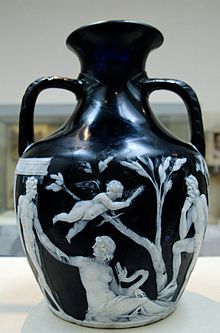Portland vase
The Portland vase is a famous Roman amphora from the early Augustusian period made using the overlay technique .
Technical: cameo glass
The actual vessel consists of dark blue glass and was covered with a layer of white glass. The pictures were cut into this white layer using a cameo technique . As it is today, the Portland vase is about 25 cm high; possibly it originally had the pointed foot expected in an amphora and was subsequently fitted with a base plate.
Picture decorations
On one side of the Portland vase - according to the most common interpretation - Atia can be seen lying under a fig tree. Apollon approaches her while Artemis witnesses the scene.
The other side shows the union of the Atia with the Snake Apollo, but at the same time the god can also be seen in anthropomorphic form. Eros hovers over the scene . Quirinus-Romulus observes Augustus' conception.
history
Allegedly found in a sarcophagus in the vicinity of Monte del Grano, the vase was initially in the collection of the Italian Cardinal Francesco Maria Bourbon Del Monte and then came into the possession of the Barberini in 1642 and was kept in the Palazzo Barberini . In older representations it is therefore sometimes also referred to as a barberini vase. In 1780 it became the property of a Scotsman and was then sold to Sir William Hamilton , the English envoy in Naples. The next owner was Margaret Cavendish Bentinck , Duchess of Portland, on whom the current name for the vase goes back, and later her son William Cavendish-Bentinck, 3rd Duke of Portland . Finally, the vessel came on loan to the British Museum in London in 1810 . In 1845 the vase was deliberately smashed into 189 pieces by a 19-year-old Irish student; the restorer John Doubleday then put the parts back together again. In 1945 the British Museum was finally able to purchase the valuable piece.
Since 1790, the Portland vase has also served as the company logo of the Josiah Wedgwood & Sons porcelain manufacturer . This company also copied it in the form of special stoneware , so-called Wedgwoodware . John Keats ' Ode on a Grecian Urn is said to be inspired by the Portland Vase.
In more recent times, the ancient origin of the Portland vase has been disputed. Instead, the art dealer Jerome M. Eisenberg attributed it to a Renaissance artist ; he argued that the art of making cameos was far more developed on the Portland vase than on comparable antique vessels, so the amphora must be younger than this. In addition, the mythological figures depicted cannot be clearly classified; it could be an inaccurate reproduction of a scene with Mars and Rhea Silvia , which can be seen on a sarcophagus from the Villa Mattei in Rome and has been well known since the Renaissance. After all, the winged, floating Eros is highly unusual for an ancient representation. Eisenberg's thesis was rejected by the experts at the British Museum. However, the exact age of the vase cannot be determined as it would damage the vessel.
literature
- W. Mancowitz: The Portland Vase and the Wedgwood Copies . London 1952.
- Erika Simon : The Portland Vase . Mainz 1957.
- Denys Haynes : The Portland Vase , London 1964 (on this review by Hans Möbius , in: Gnomon 36, 1964, pp. 636-637).
- Karl H. Hunger: The Secret of the Portland Vase. About the possibility of seeing through a crystal clear Augustan image motif after 2000 years . Munich 1988.
- N. Williams: The Breaking and Remaking of the Portland Vase . London 1989.
- W. Gudenrath, Kenneth Painter, David Whitenhouse: The Portland Vase . In: Journal of Glass Studies 32, 1990.
- Beauty and truth. Scholars' dispute over the Portland Vase in the British Museum. In: Neue Zürcher Zeitung , September 3, 2003
- Robin Brooks: The Mystery of the Portland Vase . Druckworth, London 2004.
- Susan Walker: The Portland Vase . The British Museum Press, London 2004.
- Hans-Christoph von Mosch: The Portland vase in the light of a sensational new discovery . In: Quaderni Ticinesi 39 (2010) pp. 195–222.
Web links
Individual evidence
- ↑ Colin Dunkerley: 7th February 1845. Portland Vase. A Date with History blog.
- ↑ Jacob Simon: John Doubleday . Retrieved September 5, 2019.

